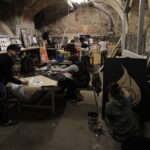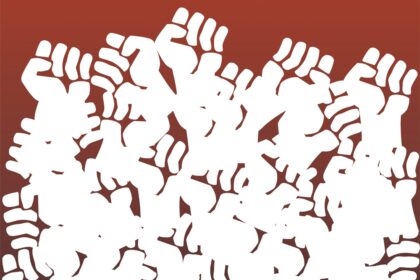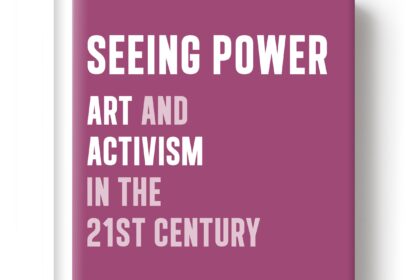Basically Ignore the Exhibition
Response to Noah Fischer’s “Agency in a Zoo: The Occupy Movement’s Strategic Expansion to Art Institutions”
Sebastian Loewe
The demise of the Occupy protest movement might be a historical preface of something bigger to come or maybe already the end of a movement of direct democracy. But one thing is for sure: the Occupy movement didn’t deteriorate in 2012 because they chose to contribute to art biennials. States forced protesters and occupiers to roll over and show their bellies, to retreat and leave the battlefield arms raised. One cannot underscore enough the role that several democratic states played in ending the movement by relentlessly evicting the Occupy camps. Zuccotti Park and all the other protest venues were brought down hard. Noah Fischer’s essay “Agency in a Zoo: The Occupy Movement’s Strategic Expansion to Art Institutions”[1] makes that very clear. A bit less clear seems to me his concept of “zoo-ness” that his essay revolves around. Fischer introduces this concept in response to my criticism of the OWS movement’s appearance in the Berlin Biennale, as I elaborate it in the essay “When Protest Becomes Art”[2], and describes “zoo-ness” as a “useful tool”[3] for symbolically occupying art institutions. However, when it comes to explaining the implementation of this tool in the context of the 2012 Berlin Biennale, were the Occupy camp has been called a ‘human zoo’, Fischer suddenly looses interest in its own theoretical concept; but let me explain seriatim.
First, I want to briefly reply to some of Fischer’s paraphrases of my assertions and re-address the issue of art and activism. What I didn’t want to say was anything like “representation and politics don’t mix”. Obviously they do. Lots of artists, including Fischer, use artistic means to promote political criticism and ideas. I have tried to answer the question about the extent in which this concrete political artistic practice, namely the two biennial contributions by OWS, actually works for the Occupy movement. And I have tried to explain it in the light of the goals of the Occupy activists themselves. Also, I never wanted to say that the protest movement entering the Biennale was “canceling out the need to protest further”. Instead, I said that it is not that the need in general is cancelled out, but that the art installations failed to integrate or build on it. That’s a fine but important difference. I said that the political concepts handled by the Occupy protest in Kassel and Berlin, because they were transposed into the symbolic realm of installation art, were mostly perceived as something that provided aesthetic pleasure. The overall symbolic nature of the protest camp installations in Kassel and Berlin was based on the idea of an audience that overcomes its traditional passivity, engages in discussions with the activists and gets politicized. This didn’t work, for reasons I tried to explain in my essay. In a nutshell: it’s not that an audience can’t partake in discussions after all, but it is my conviction that this one did so for the sake of its own edification and not so much as a way to form a serious and consensual political will – the actual goal of the activists involved. In this way, the symbolic nature of the installations revealed its deficits regarding the transformation and activation of an audience into politicized members of the movement – or at least into sympathizers. On the contrary, it seemed that the heterogenous audience at least in Berlin saw the interventions in a surprisingly unisonous way as distasteful art installations and as such as essential expressions of the movement; as a consequence, Occupy was perceived as an immature political movement. In my essay I tried to reflect on this outcome and its causes, both impairing the success of OWS’s contributions. In reaction to the negative aesthetic perception of the art installation on the ground floor in Berlin, Fischer says that some of the activists performed a so-called horizontalization of the Kunstwerke. As he explained, activists saw the need to leave the constraints of the ground floor of Kunstwerke and directly address the institution. The criticism expressed in my essay targets the installation in Berlin and the camp in Kassel. As for the horizontalization which remained invisible for most of the viewers, it certainly circumvents the audience’s depoliticization by directly facing the staff as politicized members of the art institution.
Second, I want to take a closer look at Fischer’s concept of “zoo-ness”, a supposedly “useful tool” for occupation in art institutions, as well as a tactic to intervene “neoliberal cultural landscapes”. What comprises this concept of “zoo-ness”? Fischer understands “zoo-ness” as a metaphor (I’d say it’s an allegory) for a capitalist system that hunts down people for corporate profit and puts them on display. “Zoo-ness” is also an allegory of the Occupy camp at Zuccotti park, as Fischer reminds us that protesters where often regarded as zoo animals. Furthermore the “zoo logic” of total exposure also applies to Occupy’s BB7 exhibition and not only to the participants, but confusingly also to the audience. At the same time, “zoo-ness” stands for the very opposite, for a “flipping of the neoliberal zoo logic”. In his vision of “zoo-ness” Fischer identifies the same mechanisms of “visual domination by the market”, inequality and corruption with a quality of resistance. What has been the reason for struggle, control and powerlessness mysteriously turns into an instrument of emancipation. By simply reversing signs, Fischer turns the former negative effect of the zoo allegory into a positive one. “Zoo-ness” in this conjecture is a ambiguous figure that stands for a ruthless capitalist world of surveillance and exposure and at the same time for a liberation from all that. In this vision the same content and methods serve both complete ideological manipulation and fundamental emancipation from it. Fischer’s understanding of “zoo-ness” sounds much like the rather effortless historical idea of an over-affirmative criticism, of a revolutionary critique that derives from the very structures that produce ideology. In this mechanical image and understanding, misappropriation and subversion trigger a pole reversal of an otherwise omnipotent economic and political order, suddenly revealing the true nature of capitalism and art. In a sort of abstract defictionalization and reversion the “revolutionary potential” of “zoo-ness” is then activated, Fischer concludes.
Interestingly, it all comes down to the participation in Berlin Biennale 7 where “zoo-ness” vanished in Fischer’s essay. Key to understanding BB7 and its occupation is not the abstract “zoo-ness”, but foremost the curator, his career and intentions, as well as the hidden dynamics and tensions within the group of occupants. Fischer explains that the public could not pick up on these important dynamics which were “worlds apart from available catalogues and wall texts”. So Fischer and other activists decided to “basically ignore the exhibition” and approach the art institution directly. The “zoo-ness” in this report did never serve as a useful tactic or tool. In fact, it seems like the ground floor exhibition was all the more an arena of ignorance, misunderstanding and “illusion” as described earlier by Fischer. On the contrary, activists decided to engage in a tactic that resembled a “Trojan Horse”: the “horizontalization” of the art institution that hosted the Biennale. But if all that “zoo-ness” was not necessary for the art practice and is not necessary for the theoretical explanation of Occupy’s contribution to BB7 why come up with a theoretical concept in order to defend an idea that is not even pivotal in understanding the situation in Berlin? As a member of the protest movement, why hang on to the idea of a symbolic representation within the institutional art space, when one has already ignored – hence abolished – it? Since the movement’s political qualities are judged based on aesthetic criteria, why not refrain from Biennale art and hence edification, for an already very saturated globalized art audience? Why not find a critical practice that exceeds the narrow boundaries of an aesthetic practice fitted into the visual constraints of an art biennial? In a way Fischer and other activists already answered these questions practically. They moved on to the direct action of horizontalization in response to theirs and the public’s perception of what was taking place at BB7’s ground floor. To assess this intervention impartially based on the description given by Fischer in his essay is almost impossible. Since it was a process mostly hidden from the public I cannot comment on the actual experiences and the insights it provided. But judging from remote distance it seems to me that this experiment, that was not only undertaken to question, but to “transform neoliberal hierarchies”, comprises some conceptual difficulties. Aside from the aspect of actual change, it seems to me simplistic to assume that a substantial contentual critique of an institution like a museum and its political and economic purpose, could be accomplished by simply disturbing the order and applying an organizational method practiced on the squatted squares. The formalist idea of questioning hierarchies without criticizing the overall purpose of these hierarchies seems unrewarding. This being said, I have to underscore that the experiment certainly questioned hierarchies. Which thought-provoking insights the people involved gained, we don’t know. At the end some quit their jobs.
Third, I want to make a very brief annotation regarding the relationship between private and public, hoping to question well-beloved convictions and to contribute to a discussion that might also fuel future counter-hegemonic concepts and artistic actions. It seems to me that not just Fischer’s essay iterates a certain understanding of fundamental “contradictions between democracy and capitalism”, hence between the public and the private. In this understanding of social, economic and political reality the public stands for all the good because it serves the people, whereas the private stands for all the bad because it excludes people. In my opinion this assumption of an “invasion of the public sphere by the private” that the Occupy Wall Street Movement targeted – in this purity of a schism – this dichotomy is not justifiable. Is it not true that democracy fundamentally builds on the power of private property? In the free world everything turns into a commodity to pay for in case of need. Is it not true that democratic states nurture and protect this order of private production and consumption? Everyone is forced then to privately compete against one another, using only privately owned means and therewith earn money that can buy privately owned goods. And is it not true that the public is hence the sum of all competing free and equal private interests? The public lawfully and thus forcefully manages to restrict private interests, so that they can coexist in the first place, despite them being antagonistic. In this panorama democracy is fundamentally tied to private property and thus private interests. To question the power of private interests without even shedding the dimmest light on the nature of the public seems untenable. From my point of view it seems highly debatable whether such a simplifying dichotomy of public vs. private is something that should determine so many political discussions and protests.
As for the contributions to Berlin Biennale 7 and the Documenta 13, the protest art installations might have been a failed experiment. But from the direct intervention into the Kunstwerke institution in Berlin may evolve a new artistic practice in conjunction with Occupy. I for myself am persuaded that there is still a lot of political thought to be conducted that could contribute to the relationship of protest and art practices.
Sebastian Loewe, born in 1978 in Potsdam, Germany, received a Bachelor of Arts (B.A.) in media and communication studies and a diploma in fine arts (M.F.A. equivalent). Loewe studied in Bochum and Halle, Germany as well as in Tokyo, Japan. He is currently writing his doctoral dissertation on a scholarship by a German research foundation. The working title is “Discourse On Kitsch”, a foundational study of kitsch theories as well as a discourse analysis of kitsch judgments in print media after 1989. Loewe also works in the academic and artistic field of art and politics, gives talks and workshops on topics like cultural policy, political art, political theater, self-organization in the arts or artists’ protest movements. He is the founder of the socially engaged art and discourse platform ufo-University, published in several magazines and recently edited the book “Das Elend der Kritik” (The Affliction of Critique), published by The Green Box Art Editions, Berlin. Loewe is a visiting lecturer at the University of Art and Design Burg Giebichenstein, Halle, Germany. He lives and works in Berlin, Germany.
Notes
[1] https://field-journal.com/stagejanV2/issue-2/fischer
[2] https://field-journal.com/stagejanV2/issue-1/loewe
[3] All quotes, if not indicated otherwise, stem from Fischer’s essay.
[4] Why use tropes to categorize and describe reality? Fischer criticizes the “confusion between picture and reality” without realizing that this allegory of a “zoo-ness” does exactly that: offering a picture of a life in cages as a simplifying explanation for complex social, political and economic reality.
[5] https://field-journal.com/stagejanV2/issue-2/fischer











